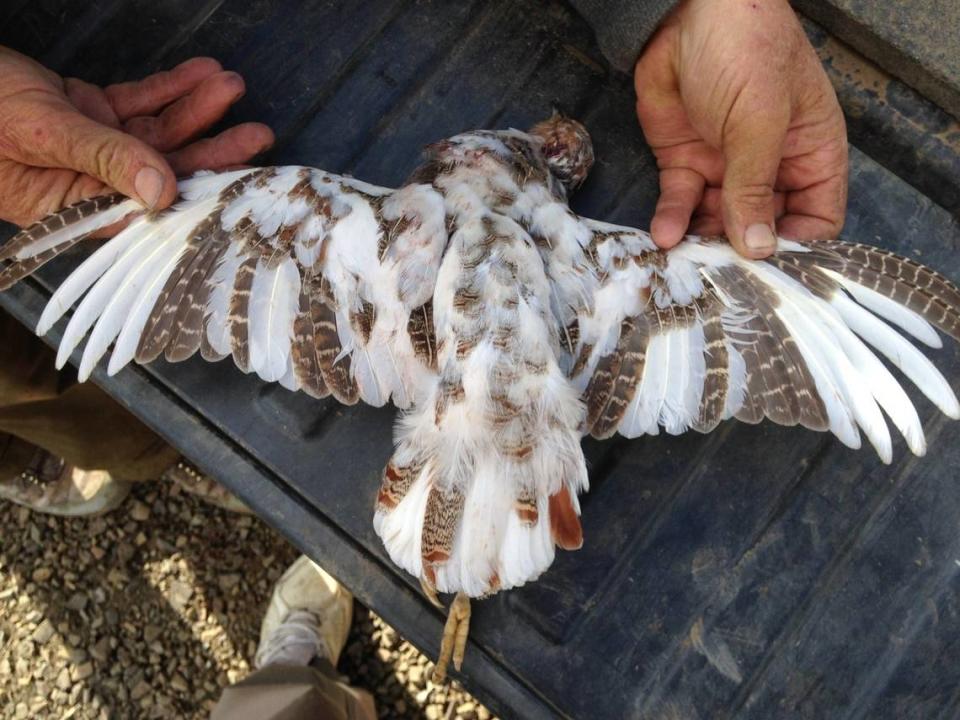‘Never seen anything like that’: Idaho hunter finds unusual ‘piebald’ gray partridge
An Idaho hunter discovered an unusual bird while on a hunting trip on Oct. 7 in the Cecil D. Andrus Wildlife Management Area near Cambridge.
Tim Franks, of Mountain Home, was upland bird hunting — pursuing nonaquatic species like grouse and partridge — in the Idaho Department of Fish and Game-managed wildlife area, which is north of Weiser near Brownlee Reservoir. Franks said his dog flushed a covey of gray partridge, and he was “awestruck” by one of the birds that took flight.
Gray partridge, which are also known as Hungarian partridge, are small game birds that typically weigh about one pound. Their feathers are gray with rust-colored stripes and orange faces. Males often have a rust-colored marking on their chests.
The one Franks shot was different. This bird had bright white feathers with a few mottled “normal”-colored feathers interspersed.
“We were just stunned at the color of the bird,” Franks said in a phone interview.
In 60 years of hunting, Franks said, he’d never seen anything like it. Unlike some other bird species, gray partridge do not change colors with the seasons. Franks said if he wasn’t so familiar with the “very distinct wingbeat” of the Hungarian partridge, it may have been difficult to identify the bird.
Franks took the partridge to the wildlife management area office, where Fish and Game biologists were equally surprised.
Aaron Switalski, a regional wildlife biologist for the Andrus WMA, said he was puzzled at first.
“To be honest, I thought, ‘Is that a gray partridge?’” Switalski said of his first impression.
He and fellow wildlife expert Zach Huling concluded that the bird was leucistic, meaning it lacked melanin pigment in some of its feathers. Its partial coloring is commonly referred to as piebald in other species, like horses and deer.
“It’s a rather uncommon, sometimes pretty rare condition,” Switalski said.
Unlike albino animals, leucistic ones do not have pink eyes and pale skin.

Switalski said the condition, typically caused by a genetic mutation, usually doesn’t adversely affect the animal. In some cases it can make an animal easier for predators to spot, and Switalski said different coloring could prove detrimental for birds that display plumage to attract a mate.
The biologist said he’s never seen a gray partridge with leucism before, either, but he said he’s familiar with studies that refer to birds with the condition.
“Everybody that’s seen it is like, ‘We’ve never seen anything like that before,’” Franks said.
So he decided more people should see it. Rather than take the bird home with him, he donated it to Fish and Game to taxidermy and display in the Andrus WMA office.
“I think that’s where it belongs, where the public can view it,” Franks said.
Switalski was surprised at the offer.
“At first we were like, ‘Awesome, Tim, it’s a really unique bird,’” Switalski said. “It would be a neat centerpiece or showpiece for him. He wondered if we’d be interested in having it.”
Switalski said he’s grateful to Franks for the donation and said it will serve as a conversation starter for other visitors.
“It shows your everyday upland bird hunt can turn into something special,” Switalski said.

